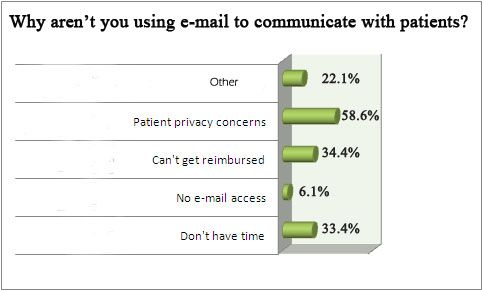2010 Tech Survey: Why Not E-mail With Patients?
Only about 38 percent of respondents to our 2010 Technology Survey said they e-mail with patients. But increasingly, patients are demanding online interactions with their physicians.
Note: This is the second in a series of blog entries delving into the results of our 2010 Physicians Practice Technology Survey. Full results are now available at www.physicianspractice.com/technology-survey.
You likely communicate via e-mail with just about everyone in your life, as well as receive a slew of e-mails for everything from news alerts to Netflix notices to credit card updates. So why not e-mail with your patients?
Only about 38 percent of respondents to our 2010 Technology Survey said they e-mail with patients. As for the reason why most are hesitant to do so, the main reason was patient privacy concerns. Practices also drag their feet with online communication because they can’t get reimbursed or they don’t have time.

But increasingly, patients are demanding online interactions with their physicians. At Jeff Livingston’s OB/GYN practice, connecting with patients online started through social media, with Facebook, and soon patients were expecting more. “If you’re going to be out there and you are teaching patients to be online and be engaged, you have to have a system in place to allow them to do that,” Livingston told me in a recent interview for an article on social media.
So what did they do? They developed a system to communicate online with patients. His practice implemented a patient portal, where they can securely transmit messages to and from patients. It works like bank correspondence: You receive an e-mail telling you a message is waiting for you, so you log into the secure portal to view it. The patient portal addressed concerns about patient privacy.
The result? “You can imagine the efficiency has gone up [and] patient satisfaction has gone up,” Livingston said.
Getting paid for e-mailing patients is still an ongoing experiment, as Robert Lowes points out in an article about “mouse calls.” Doctors can adopt a fee-for-service model or levy and annual fee for e-mailing, and some insurance companies will reimburse for the interaction (but usually those are more involved online interactions or “virtual visits.”)
One of my doctors allows patients to e-mail via the practice Web site, just for basic non-emergency questions. I’d gladly pay for the service (though from my understanding, they don’t charge), if it means a quick question is answered, saving me the time of an appointment or playing phone tag after leaving a message.
In our survey, 22 percent answered “other” when asked why they don’t e-mail, and provided their own reasons. A few were worried about the patients’ expectations of a timely or detailed response. Many cited liability concerns. Interestingly, several of you said they were currently implementing a patient portal or had plans to, so e-mail is on the horizon.
So let’s hear from you. Do you e-mail with your patients? If not, why not?
To read more on the Tech Survey, check out this recent post.